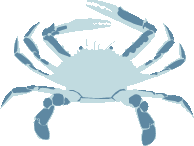Overview
The blue crab resource supports North Carolina’s second most valuable commercial fishery. Average North Carolina hard crab landings since 1994 are 40 million pounds with an average dockside value of $28 million annually (NCDMF 2013), consistently ranking North Carolina in the top four blue crab harvesting states in the US. Coastal Heritage Seafood is a commercial buyer and processor of North Carolina blue crab, accounting for approximately 15% of the fishery production each year. It is their interest to pursue a comprehensive FIP with the goal of MSC certification.
Measured against the MSC standard, the fishery in its current state scores well in two of three principles surrounding management and impacts on the surrounding environment/other species. The fishery boasts an excellent state management system that collects both fishery dependent and independent data, as well as a robust fishery management plan with a harvest strategy. The fishery also demonstrates an exceptionally clean catch, with 99% of the catch being hard shell crab. The remaining 1% of the catch include blue crabs known as soft shell, peelers, and non-target species includes at least ten different finfish species and occasionally a diamondback terrapin, a species of concern (and the primary driver behind Monterey Bay Seafood Watch red Avoid rating).
However, the MSC principle focusing on target stock status and harvest strategy is the current weak point of the fishery when measured against the MSC standard, as at the time of pre-assessment based on 2015 stock statistics, the stock appears to be depleted as both the adult and recruits have fallen below the state’s levels of 75% abundance and production since 2012The current state management protocol does not include traditional reference points for the determination of overfishing or being overfished, nor does it provide the opportunity to evaluate the potential effectiveness of a management action that may potentially improve stock abundance. Because there is no independent observer program for the NC blue crab pot fishery, there are no recent data that can be used to characterize catch composition, including documenting interactions with species of concern.
At present time, the North Carolina blue crab pot fishery does not meet MSC standards with respect to the abundance of the target species, and because of the lack of an analytical model for stock assessment, it is impossible to evaluate the effectiveness of management measures to rebuild the stock.
The NC DMF has completed, with effective peer review, an analytical model for stock assessment that will allow for the following: better understanding of blue crab population dynamics in NC waters, the development of reference points, the evaluation of current stock status and fishing mortality against those reference points, and the evaluation of potential stock rebuilding strategies, if needed. In addition, NC Division of Marine Fisheries is planning to develop and implement a harvest strategy in accordance with the new assessment model.
The fishery does not completely meet the MSC standards for commitment to the principles to and implementation of the precautionary approach (PA). Developed by the FAO (e.g., FAO Code of Conduct for Responsible Fisheries) in 1995, the PA seeks to protect fishery resources from fishing practices which might put their long-term viability in jeopardy. As adopted in the MSC standard, the PA means being cautious when information is uncertain, unreliable or inadequate and that the absence of adequate scientific information shall not be used as a reason for postponing or failing to take conservation and management measures. The pre-assessment identified that the North Carolina management system did not explicitly incorporate the elements of the PA into the fishery management policy. Upon review for this FIP, the FIP team determined that decision making for the blue crab fishery did not demonstrate evidence of using the PA.
The blue crab resource supports North Carolina’s second most valuable commercial fishery.
Because the primary performance indicators remaining that prevent this fishery from meeting the MSC standard are management driven, and the state agency with responsibility to address management concerns (DMF) is already drafting the necessary measures to incorporate into the fishery management plan, the objectives of this FIP is for are to, through advocacy and cooperation with DMF:
1) Ensure the fishery management plan, stock assessment, and harvest strategy for NC blue crab conform to the MSC Fisheries Standard by August of year 2023;
2) Demonstrate the long-term goals/objectives of the overarching management system are explicitly consistent with the precautionary approach by August of year 2023; and
3) Demonstrate the application of the precautionary approach in the 2021-2023 FMP, as evidenced by draft revisions in the 2017-2019 FMP Review.

